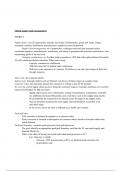Global supply chain management
Lecture 1
Supply chain; a set of organization, includes movement of information, goods and funds. Stages;
consumer, retailers, distributors, manufacturers, suppliers (some not present).
Supply chain management; set of approaches, techniques and tools that integrate and/or
coordinate suppliers, manufacturers, warehouses, and stores to guarantee the customers satisfaction. Also
maximizing profit of service level.
Customer satisfaction; e.g. ToysRus made a promise in 1999 that orders placed before December
10 will be delivered before christmas. What went wrong;
- Capacity constraint in e-fulfilment
- 350k fine from the US federal trade commission
- Deliveries were outsources to Amazon; 50 million a year and a percentage of their sale
through Amazon.
Direct sale; for corporate clients.
Indirect sale; through retailers such as Walmart; not always all these stages in a supply chain.
Customer value; the maximum amount the consumer is willing to pay for the product.
SC cost; the cost of supply chain incurs in filing the customers request. Example; purchases of a wireless
router from BestBuy for 60$ (revenue);
- Supply chain incurs costs; information, storage, transportation, components, assembly,
etc. (difference between 60$ and the sum of all these costs is the supply chain profit).
- SC profitability the total profit to be shared across all stages of the supply chain.
- Success should be measured by total supply chain profitability, not profits at an
individual stage.
- In the service sector the story is different (e.g. health care system).
Push/pull view;
- Pull; execution is initiated in response to a customer order
- Push; execution is initiated in anticipation of customer orders; based on forecasts rather than
actual demand.
Push/pull boundary; separates push processes from pull processes.
- The goal; identify an appropriate push/pull boundary such that the SC can match supply and
demand effectively.
- What is the effect of having more pull rather than push processes in SC?
- E.g.; Gateway vs Apple;
- Gateway, 1985, directed sales of PCs, no finished goods inventory for
practicalities sold.
, - Apple, 2001, always carried product inventory in retail stores, little variety,
successful.
- E.g.; Zara by Inditex;
- Strategy; highly responsive to changing trends with affordable prices (4-6 weeks
instead of 6 months).
- Zara sells most products full price. They are flexible and can quickly source from
Asian locations adapting to the taste and demand.
Managing the flows;
- Flow of funds
- Flow of goods (forwards and backward SC)
- Flow of information
To maximize SC surplus;
SC surplus = consumer vale - SC cost
= consumer value - price -> consumer surplus
+ Price - SC cost -> SC profitability
Consumer value; the maximum amount the consumer is willing to pay for the product
SC cost; the costs the supply chain incurs in filling the consumer's request.
Decision phases in a SC;
- Supply chain strategy or design
- outsource/inhouse/location
- Storage locations
- Modes of transportation
- Information systems
Supply chain design decisions are long term and expensive to reverse; must take into account market
uncertainty.
- Supply chain planning
- Goal is to maximize the SC surplus over the planning horizon
- Markets will be supplied from which locations
- Subcontracting, backup locations
- Inventory policies
- Timing and size of market promotions
In planning decisions demand uncertainty, exchange rates, competition over time horizon must be
considered.
- Supply chain operation
- Time horizon is weekly or daily
- SC configuration is fixed, and operating policies are determined
- Operation decisions;
- Allocate orders to inventory or production
- Set delivery schedule
- Much less uncertainty (short time horizon)
, Supply chain is a sequence of processes;
- Cycle view
-
- Push/pull view
- Supply chain processes fall into one of the two categories depending on the timing of
their execution relative to customer demand.
- Pull; execution is initiated in response to a customer order,
- Push; execution is initiated in anticipation of customer orders; based on forecasts rather
than actual demand.
- Push/pull boundary separated push processes from pull processes, the goal is to identify
an appropriate push/pull boundary such that the supply chain can match supply and
demand effectively
Lecture 2
Achieving strategic fit in a supply chain
Competitive strategy; defines, relative to its competitors, the set of customer needs that it seeks to satisfy
through its products and services. It specifies one or more customer segments to focus on. Competitive
strategy is based on customers’ priorities.
Value chain; core processes and functions, support
processes. To execute a company’s competitive
strategy, all the functions in the value chain play a
role and each must develop its own strategy.
Supply chain strategy; defines the nature of all the
functions, it actually specifies what each function
should do particularly well. Also includes design decisions regarding inventory, transportation, operating
facilities, and information flows.
Implied demand uncertainty;
- Electricity is a functional product (predictable demand) but the supply may have
breakdowns.
- Fashion is an innovative product (unpredictable demand) but the supply is usually very
stable.





